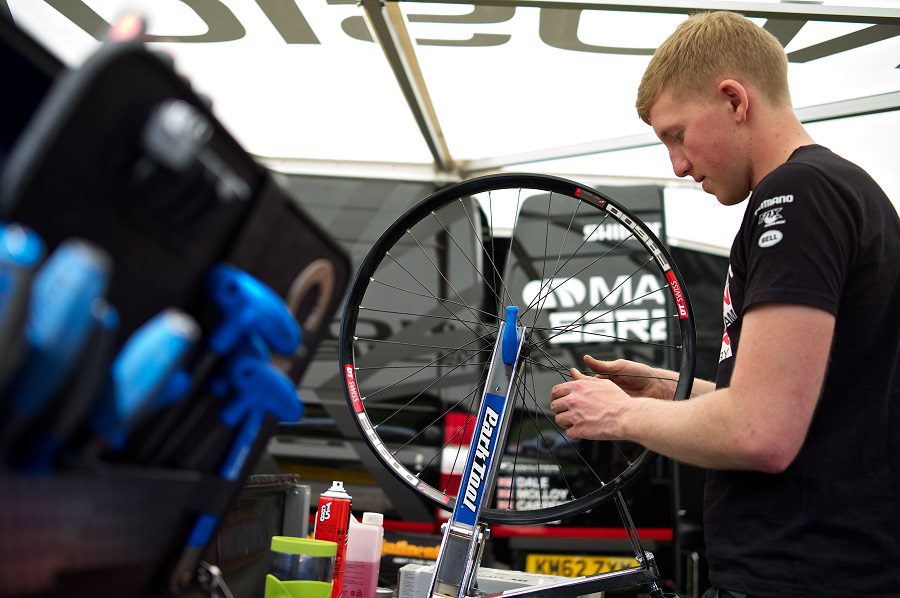The five-minute wheel inspection: Make sure those hoops keep rolling along
You can extend the life of a bicycle wheel tenfold by taking a of couple minutes to check it over.

by Chad Grochowina

You can extend the life of a bicycle wheel tenfold by taking a of couple minutes to check it over. A top-notch carbon-fibre racing wheel won’t function well if the spoke tension is unbalanced, the hub is loose or bearings are tight and crunchy. Think of it as simply protecting your investment: by keeping wheels in good condition, you can be assured of a long life and years of enjoyment as you rip along the road or trail.
Start with the wheels still on the bike to determine the condition of the hubs. Wiggle each one from side to side, feeling for play or knocking in the bearings. Spin each wheel and listen to how smooth it is. If there is an audible rumble, the bearings will need to be replaced. Hubs with cup-and-cone races will require new loose ball bearings. The hubs can be adjusted with a pair of cone wrenches, Allen keys or both. If your hubs have cartridge bearings and don’t have a preload adjuster, the chances are you’ll need new bearings.
By keeping wheels in good condition, you can be assured of a long life and years of enjoyment as you rip along the road or trail.
You can also check the condition of the rims with the wheels on the bike. Give each wheel a spin to determine how straight it is. Uneven spoke tension or a bent rim causes wobble. Squeeze pairs of opposing spokes, paying attention to any differences in tension. If the rim has a wobble and there’s uneven spoke tension, the rim is most likely out of true. Next, look for any hops in the rim. An experienced wheel builder can often fix an egg-shaped wheel. If there is a large flat spot between just a few spokes, the rim is likely bent. Technically, a flat spot in an aluminum rim can be bent back, but realistically, the integrity of a wheel is compromised whenever a rim has to be physically manipulated. Carbon-fibre rims, on the other hand, can’t bend. If the wheel is out of true, it’s either due to uneven spoke tension or a crack. You should get a mechanic with carbon-fibre wheelbuilding experience to make the final diagnosis on the wheel.
Now it’s time to take the wheels off the bike to examine the hubs further. Spin each the axle by hand. Pay attention to how smooth (or crunchy) the axle feels. If it’s not silky smooth, you’ll need to do an overhaul. For the rear hub, inspect the freehub body by spinning the cassette counter-clockwise. If it spins freely, it’s likely OK. If there’s any sluggishness, that overhaul should take care of it.

Braking wears down brake tracks on the rims. Whether the rims are carbon fibre or aluminum, a convex groove will develop as the braking track wears; if left too long, it will eventually crack. You can slow this process by using the appropriate brake pads for the rim material. Also, keep your pads free of dirt and debris. Pick out any chunks of dirt and aluminum from the pads and follow with a light sanding to deglaze them. With aluminum wheels, inspect the rim around the spoke holes looking for hairline cracks, especially on the rear wheel. It’s not uncommon to see these cracks on older wheels. If you do see cracks, you will need to replace the rim as the wheel can no longer hold proper tension.
Spokes are only as strong as the weakest one on the wheel. If the wheel sheds spokes continually, it needs to be de-tensioned and brought back up to even tension. This is a job for an experienced wheel builder.
It only takes a few minutes to determine if your wheels need more attention. A good rule of thumb is to examine them whenever you wash your bike. A dirty wheel can often hide underlying problems, such as spoke-hole cracks. You want to keep everything in top shape so you’ll roll smoothly down the road or trail.
